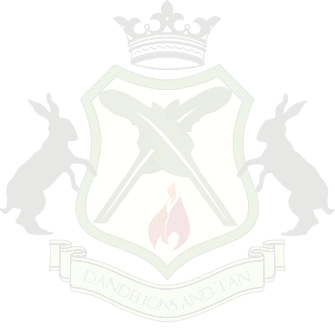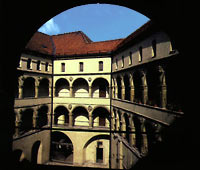



Zosia describes her research to reveal her family story like this:
As every member of a noble family does, I have intensively investigated my family history. As you can imagine this is not very easy for a rabbit like me. First there is the human historical research that simly ignores the history of us rabbits (the strategy of the cats is once again completely successful!) and second I simply cannot manage to get out of my residence. So my only method of research is the internet. But because of a very strong verbal tradition and intensive research on the internet I have managed to collect the most important and most interesting facts of a long family tradition.
No noble family without a heraldic representation. You can see the heraldic of Zosia here.
1189
 The first known member of my family is a brother of King Richard Lionheart of England (that is in the time of the crusades). The humans only know of two brothers (Richard and John) but there was a third, Edgar Dent de Lion, Dandelion. He took the side of Richard in his fight against his brother John and was afterwards awarded the crown of Scotland and the proud castle Ravenscraig by Richard (Picture 1).
The first known member of my family is a brother of King Richard Lionheart of England (that is in the time of the crusades). The humans only know of two brothers (Richard and John) but there was a third, Edgar Dent de Lion, Dandelion. He took the side of Richard in his fight against his brother John and was afterwards awarded the crown of Scotland and the proud castle Ravenscraig by Richard (Picture 1).
1294
This year already marked the end of the rule of the Dandelions in the royal castle Ravenscraig. John Frederic of Dandelion lost the crown in one of the several wars between the tribes to his most fierce ennemies: the family of the Purrs. He fled with his loyal friends to his second castle Dunottar, a castle at the coast (Picture 2).
1371
After a long time as an familiy of outlaws the year 1371 marked the turn upwards. The Stuarts who were related to the Dandelions conquered the throne of Scotland. They invited Nepomuk the Saint to join them near the scottish court but true to his name, Nepomuk the Saint preferred to stay on his castle Dunottar to live the life of a hermit. The location on a cliff was ideal for the very reclusive and religious man. His decendent followed his style of life and so it the family lived a very calm live for the years to come.
1559
But then the reformation flooded Eurola and also the British Isles and the family of the Dandelions were not excluded from the disturbance it brought. It was Henry the Catholic that was most active in the fight against the Englishman who tried to intervene in favour of the Calvinist. It was because of him that the Dandelions got there second name: the Tans. They were given it for their fierce fight for the catholic believe.
1587
 A black year for Scotland and the Dandelions and Tans. Maria Stuart was executed in England and the most fierce representatives of the catholic believe and friends of the Stuarts fled to France. One of them was Charles Philip of Dandelions and Tan. It was a great luck that Dunottar was at the coast and only hard to be reached by land. So he managed to flee even though his castle was beleagered by the troups of Count Cat of Moor, also called Murr (a very deceitful character: for years he pretended to be a faithful friend and catholic but at the same time he formed an alliance with the English). He climbed down the dangerous cliff under his castle and so reached the ship that was to bring him to France.
A black year for Scotland and the Dandelions and Tans. Maria Stuart was executed in England and the most fierce representatives of the catholic believe and friends of the Stuarts fled to France. One of them was Charles Philip of Dandelions and Tan. It was a great luck that Dunottar was at the coast and only hard to be reached by land. So he managed to flee even though his castle was beleagered by the troups of Count Cat of Moor, also called Murr (a very deceitful character: for years he pretended to be a faithful friend and catholic but at the same time he formed an alliance with the English). He climbed down the dangerous cliff under his castle and so reached the ship that was to bring him to France.
1589
After two years which he spent near the french court he met Countess Ludmilla the Younger from Krakau (Poland). They fell in love and as Charles Philip had nothing to lose in France he followed her to Krakau and there they got married after a year. It was a very splendid marriage which was talked about for the years to come. Not a surprise as it was a very beautiful pair!
1591
But there were also black sheep in my family: because of a family feud during which the brother of Ludmilla, Hugo The One Without Tail, tried to inherit the throne before time by murdering his father, Charles Philip and his wife Ludmilla became the rulers of the principality Wieliczka in the sout-east of Krakau. They changed their name to "Lohowski" (Dandelion and Tan was first too long and then the Polish could not pronounciate it correctly).
1608
 After the extinction of the family of Szafraniec Walburga The Bearded of Lohowska inherited the castle Pieskowa Skala (Picture 3). This lies 40km in the north of Krakau. With this they could expand their region of reign. My family came to rest once again and reigned their principality until
After the extinction of the family of Szafraniec Walburga The Bearded of Lohowska inherited the castle Pieskowa Skala (Picture 3). This lies 40km in the north of Krakau. With this they could expand their region of reign. My family came to rest once again and reigned their principality until
1772
In this year Poland was divided for the first time and there was no calm living possible once again. Thaddeusz The Baldheaded as representant of the family of Lohowski took sides against the Russians This made him a favorite with his subjects. His daughter, Jadwiga Rozsadna of Lohowska, continued his fight against the Russians.
1794
In the uprising under Thaddeusz Kosciuszko Ryszard Karol Drobny of Lohowski supported the polish national hero. So he allowed him to hide in his residence Pieskowa Skala and lot more. His son Alexander The Limp Eared (he was called like this because of his hanging ears which he inherited from his mother) followed his example. But the resistance against the Russians was not successful.
1830
the Russians made Poland a Russian province and all that had fighted against them had to flee under cover of the night. One of them was Grzegorz Jan Lohowski, who didn't flee like most polish emigrants to Paris, but settled down in the region of Bern (Rohrbach to be precise). As Lohowski was a bit hard for Swiss tongues, the Lohowskis changed the name to Loh. This Grzegorz Jan von und zu Loh is the ancestor of all von und zu Loh. My father was called Bodo von und zu Loh the Sensible, who was rather ruled by Carla of Braun, called the Strong (my mother).
Unfortunately I don't know much about the family tree of my mother. I only know that she is a decendant of an old German family. Her father was Reinhold VI better known as The Monster (rein means pure and monster is called Unhold in German), who only became a good family head with the help of Hermine The Strict and so managed to strengthen a weakening dynasty. Then my mother told me a lot of Johanna The One With The Gentle Paws, who the humans know as empress Maria Theresia of Austria.